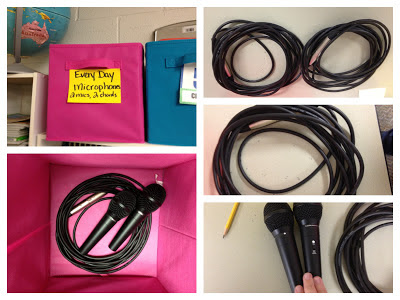Have you noticed that when you teach elementary music, you suddenly become a sound technician? You might not know a coaxial cable from a quarter inch, but suddenly, you are the on call expert in all things related to sound…..
 Everything I know about sound can fit into a thimble. Everything I know about sound I picked up on the fly and one thing I know is that microphone cords are always the first thing to go wrong, especially when they are handled by people who don’t know how to take care of them. These are my new microphones and cords from donorschoose.org. These are the “every day” microphones I got so that the “performance” microphones would last longer……
Everything I know about sound can fit into a thimble. Everything I know about sound I picked up on the fly and one thing I know is that microphone cords are always the first thing to go wrong, especially when they are handled by people who don’t know how to take care of them. These are my new microphones and cords from donorschoose.org. These are the “every day” microphones I got so that the “performance” microphones would last longer……
99.9% of the time I am the one setting up the sound and I’m the one who chooses the microphone for the occasion. 99.9% of the time I know well in advance what is needed and there is no problem at all….. And yet, there are still times when “sound emergencies” (like fire drills) occur and I’m knee deep in teaching….. So with that in mind, here are a few tips.
1. If you are in a large district, they will have sound techs….GET HELP!!!! My favorite resource in my district is the sound equipment we can order. They bring it, show me how to set it up, I guard it and then when the performance is over, they take it away. It’s AWESOME!
2. Work toward the right equipment. No one is a good audience when they can’t hear the performance. Your students deserve to be properly heard. This may take some time and ingenuity. Sometimes PTA is a great resource, I was able to replace and acquire needed sound equipment from donorschoose.org.
3. Teach at least 3 other people how to turn on the system that you have and how to plug in a microphone. I would teach the people who might be giving you a call in a “sound emergency”….. The principals, the librarian, and maybe a grade level teacher or instructional coach who might need it.
4. Teach at least 3 other people, how to wrap a cord without damaging it. The general wisdom that I’ve noticed is that you don’t force the cable into a certain shape, you guide it. There is a feel to it and I can’t teach that here, but if you are forcing your cables to wind around something, the chances of them getting a short are really high. Easy does it!
4. Don’t keep all of your eggs in one basket. In my school the microphones in the cafeteria get used EVERY day. Therefore, the sound closet is not kept locked. Therefore, I don’t keep the microphones in the sound closet. That way, if someone walks out of the school with something, the sound ship isn’t completely sunk.
5. Keep a set of microphones and cords neatly stored within reach. If you are at a music teacher meeting across town and the PTA president calls and says, “Hey we need a microphone..” You need to be able to say, They are in the bright pink container next to my desk.
3. As funds permit, keep an everyday set and a protected performance set. They don’t even have to be that expensive, they just have to be protected. Cheap and protected sound equipment is better than harshly used and damaged expensive equipment any day.

